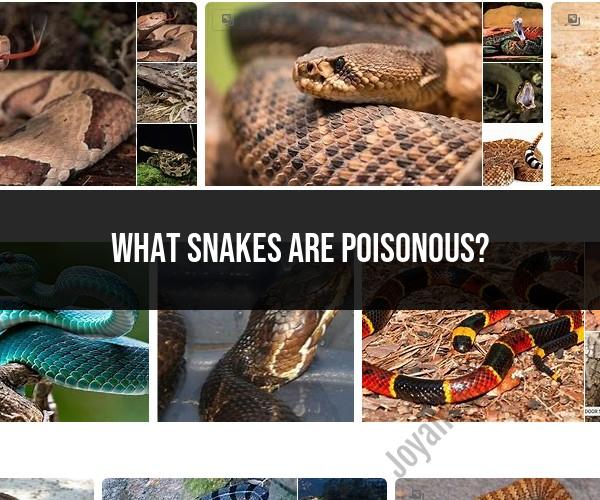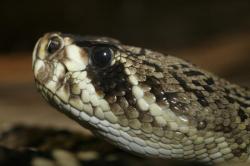What snakes are poisonous?
It's important to clarify the terminology used when discussing snakes and their venomous properties. Snakes are not "poisonous"; they are "venomous." The distinction between the two terms is crucial:
Venomous: Snakes that are considered venomous possess specialized glands and fangs that allow them to inject venom into their prey or potential threats. This venom is primarily used for hunting and defense.
Poisonous: "Poisonous" typically refers to organisms that are harmful when ingested or touched. Poisonous organisms, such as certain plants or frogs, release toxins that can be harmful if consumed or if their secretions come into contact with the skin. Snakes are not considered poisonous because their toxins must be injected into the body through a bite.
There are many venomous snake species around the world, and their venom can vary in potency. Some of the most well-known venomous snake species include:
Cobra: Various species of cobras, such as the King Cobra and the Egyptian Cobra, are highly venomous and found in different parts of the world.
Viper: Vipers are a family of venomous snakes that includes species like the Russell's Viper, the Gaboon Viper, and the Saw-scaled Viper.
Pit Viper: Pit vipers, like the Copperhead, Cottonmouth (Water Moccasin), and various rattlesnakes, are known for their heat-sensing pits and potent venom.
Elapid: Elapids are a family of venomous snakes that includes the Black Mamba, the Taipan, and various coral snakes.
Fer-de-Lance: The Fer-de-Lance is a highly venomous snake found in Central and South America.
Inland Taipan: Also known as the "Fierce Snake" or "Small-scaled Snake," this Australian snake is considered the most venomous snake in the world.
Sea Snake: Many species of sea snakes are venomous, and they are found in oceans and coastal waters.
It's important to note that not all snakes are venomous, and most snake species are harmless to humans. In fact, the majority of snake bites worldwide are caused by non-venomous snakes. Nevertheless, it's crucial to exercise caution and avoid provoking or handling any snake in the wild unless you are trained to do so safely.
If someone is bitten by a snake and there is uncertainty about whether the snake is venomous, it is recommended to seek immediate medical attention. Identifying the snake can be helpful, but medical treatment should not be delayed, as some non-venomous snake bites can also cause infections and other complications.
Treating Venomous Snake Bites: First Aid and Medical Care
If you are bitten by a venomous snake, it is important to seek medical attention immediately. However, there are some first aid measures that you can take to help reduce the severity of the bite and improve your chances of recovery.
First Aid
- Move away from the snake. Do not try to kill the snake, as this may startle it and cause it to strike again.
- Stay calm and keep the bitten limb still. Venom travels through the bloodstream, so it is important to slow the flow of blood to the bite.
- Remove any jewelry or clothing that is restricting the blood flow to the bitten limb.
- Clean the bite wound with soap and water.
- Apply a pressure bandage to the bitten limb. The bandage should be firm but not too tight. You should be able to slip two fingers between the bandage and the skin.
- Transport the victim to a medical facility as soon as possible.
Medical Care
At the medical facility, the victim will be assessed and treated accordingly. Treatment may include:
- Antivenom: Antivenom is a medication that can neutralize the venom in the bloodstream. It is most effective if given within 30 minutes of the bite.
- Pain relievers: Over-the-counter pain relievers, such as ibuprofen or acetaminophen, can be used to relieve pain and inflammation.
- Antibiotics: Antibiotics may be prescribed to prevent infection.
- Tetanus shot: If the victim is not up to date on their tetanus shots, they will need to receive a tetanus booster.
The victim may also need to be hospitalized for observation and further treatment.
When Venom Strikes: Immediate Response to a Snake Bite
The first few minutes after a snake bite are critical. It is important to act quickly and calmly to prevent the venom from spreading.
Here are some tips for immediate response to a snake bite:
- Stay calm and keep the bitten limb still.
- Move away from the snake.
- Remove any jewelry or clothing that is restricting the blood flow to the bitten limb.
- Clean the bite wound with soap and water.
- Apply a pressure bandage to the bitten limb.
- Call 911 or your local emergency number.
Snakebite Survival: Properly Handling a Venomous Encounter
The best way to survive a snake bite is to avoid being bitten in the first place. Here are some tips for properly handling a venomous encounter:
- Be aware of your surroundings and watch for snakes when you are hiking, camping, or working outdoors.
- Wear sturdy shoes and pants to protect yourself from snakebites.
- Avoid putting your hands or feet in places where you cannot see, such as under rocks or in holes.
- If you see a snake, do not approach it. Back away slowly and leave it alone.
If you are bitten by a venomous snake, it is important to stay calm and seek medical attention immediately. By following these tips, you can improve your chances of survival and recovery.







